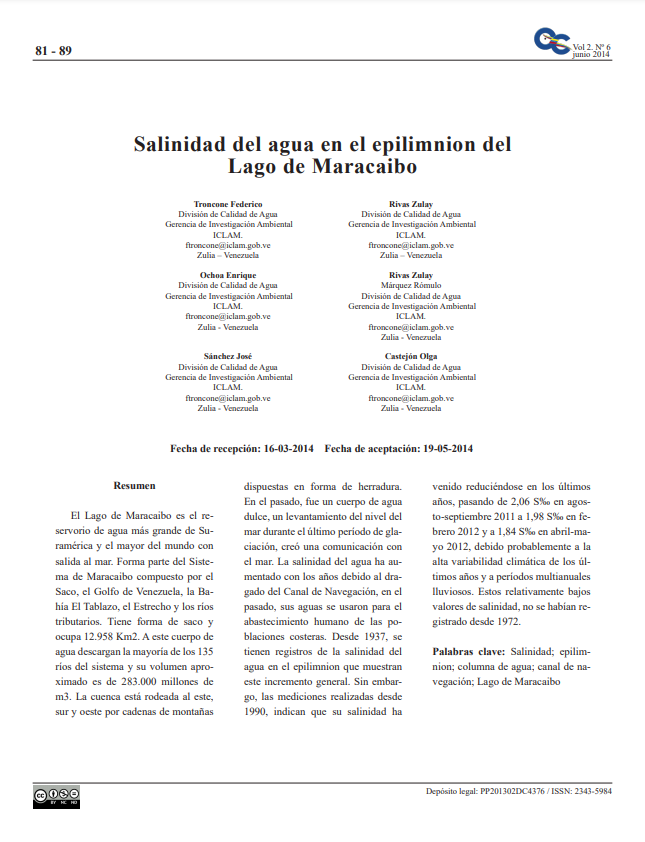Water salinity in the epilimnion of the Maracaibo Lake
Keywords:
Salinity, epilimnion, water column, navigation channel, Lake MaracaiboAbstract
Lake Maracaibo is the largest reservoir of water in South America and the largest in the world with access to the sea. It is part of the Maracaibo System composed of the Saco, the Gulf of Venezuela, the El Tablazo Bay, the Strait and the tributary rivers. It has a bag shape and occupies 12,958 km2. This body of water discharges most of the 135 rivers of the system and its approximate volume is 283,000 million m3.The basin is surrounded to the east, south and west by chains of mountains arranged in a horseshoe shape. In the past, it was a body of fresh water, an elevation of the sea level during the last period of glaciation, I create a communication with the sea. The salinity of the water has increased with the years due to the dredging of the Navigation Channel.
Downloads
References
APHA. (2005). American Public Health Association, American Water Works Association, Water Environmental Federation. Standard Methods for the Examination of Water and Wastewater. 21th Edition. Washington, USA.
Battelle. (1974). Studies on the effects of oil discharges and domestic and industrial waste-waters on the fisheries of Lake Maracaibo, Venezuela. Vol. I. Ecological characterization and industrial wastes. Batelle, Pacific Northwest Laboratories. 180 pp.
Bautista, S. (1997). Proceso de Salinización del Lago de Maracaibo. ICLAM-LUZ-CORPOZULIA.
Bermúdez, N. (2006). Los derrames de petróleo en el Lago de Maracaibo entre 1922 y 1928. En: Procesos Históricos. Revista Semestral de Historia y Ciencias Sociales. Número 9. Universidad de Los Andes. Mérida-Venezuela
Chuck, F. (1952). The Teredo problem in Lake Maracaibo. Unpublished Manuscript. Creole Petroelum Corporation.
Gessner, F. (1953). Investigaciones Hydrograficas en el Lago de Maracaibo. Acta Cient. Venezolana. 4, 173-177.
Harris, R.M. (1947). Report on freshwater investigations, Lake Maracaibo. Unpublished Manuscript. Creole Petroleum Corporation.
ICLAM. (2013). Instituto para el control y la conservación del Lago de Maracaibo. Monitoreo ambiental del Lago de Maracaibo. Informe de Resultados. IC- 2013-04-079. 40 pp.
Manugistics and Statistical Graphics Corporation (1999). Statgraphics Plus for Windows 32-Bit Operating Systems. USA
Parra Pardi, G. (1979) Estudio integral sobre la contaminación del Lago de Maracaibo y sus afluentes. Parte II. Evaluación del proceso de eutroficación. Ministerio del Ambiente y de los Recursos Naturales Renovables. Caracas. 235 pp.
Parra-Pardi, G. (1986). La conservación del Lago de Maracaibo. Diagnóstico Ecológico y Plan Maestro. Lagoven Filial de Petróleos de Venezuela. S.A.
Redfield, A.C.; Ketchum, B.H.; Bumpus, D.F. (1955). Report to Creole Petroleum Corporation on the hydrography of Lake Maracaibo, Venezuela. Unpublished Manuscript Reference 55-9. Woods Hole Oceanographic Institution.
Torres, J.C.; González, G.; Troncone, F. (2002). Determinación de sulfatos en muestras de la columna de agua del Lago de Maracaibo, Venezuela. Ciencia. 10 (2):168-177.
U.S. Army Corps of Engineers Waterways Experiment Station, (1938). Model Study of channel improvements at outer Bar Lake of Maracaibo, Venezuela. Technical memorandum N° 106-1.Volume N° 1
Urdaneta, A.; Cardozo, G.; Parra, I. (2006). Los orígenes de Maracaibo y el dominio del lago: diversidad social y mestizaje. En: Procesos Históricos. Revista Semestral de Historia y Ciencias Sociales. Número 10. Universidad de Los Andes. Mérida-Venezuela
Wetzel, R. (1981). Limnología. Ediciones Omega. S.A., Casanova, Barcelona, España.

Downloads
Published
How to Cite
Issue
Section
License

This work is licensed under a Creative Commons Attribution-NoDerivatives 4.0 International License.







